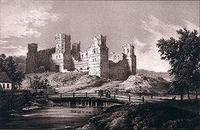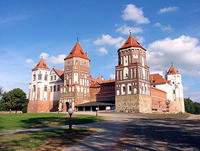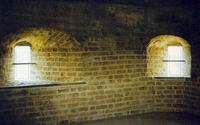You are in: Europe -> Belarus -> Mir Castle Complex, and traditional search or Image Gallery will yield results of this site only
Mir Castle Complex
| Site number: | 625 |
|
| Type of site: | Cultural | |
| Date: | 15th-19th c. | |
| Date of Inscription: | 2000 | |
| Location: | Europe, Belarus, Grodno Province (oblast), Korelichi District | |
Up to 75 images are shown here. Click on each for more details or on Image Gallery for more images.
Six official UN languages:
Arabic,
Chinese,
English,
French,
Russian,
Spanish
Other languages: Belarusian, Czech, Dutch, Finnish, Hungarian, Italian, Lithuanian, Norwegian-bokmål, Polish, Swedish
Other languages: Belarusian, Czech, Dutch, Finnish, Hungarian, Italian, Lithuanian, Norwegian-bokmål, Polish, Swedish
| Description: | Though the castle’s construction began in the late 15th century, in a Gothic style, it was later extended and reconstructed in the Renaissance and the Baroque styles. Suffering severe damage during the Napoleonic period after being abandoned for nearly a century, it was finally restored at the end of the 19th century, whereupon it experienced the addition of new elements and landscaping of its surrounding area into a park. It presently stands as a graphic testimony to its turbulent history. --WHMNet paraphrase from the description at WHC Site, where additional information is available. | |
| The Mirsky Castle Complex (Belarusian: Мі́рскі за́мак), is a UNESCO World Heritage site in Belarus located near Mir in the Karelichy District of the Hrodna voblast, 29 km to the north-west from another World Heritage site, Nesvizh Castle. The construction of the castle began at the end of the 15th century, in the Gothic architecture style. Building of the castle was completed by Duke Ilinich in early 16th century near the village Mir (formerly of Minsk guberniya). Around 1568 the Mir Castle passed into the hands of Duke Radzivil, who finished building the Castle in Renaissance architecture style. A three story palace was built along the eastern and northern walls of the castle. Plastered facades were decorated with limestone portals, plates, balconies and porches. After being abandoned for nearly a century and suffering severe damage during the Napoleonic period, the castle was restored at the end of the 19th century. In 1813, after the death of Dominik Radzivil, the castle passed into the hands of his daughter Stefania, who married Ludwig zu Sayn-Wittgenstein-Berleburg. The castle later fell into the hands of their daughter Maria, who married Prince Chlodwig Hohenloche-Schillingfurst. Their son, Maurice Hohenloche-Schillingfurst sold the castle to Nikolaj Sviatopolk-Mirski, of the Bialynia clan, in 1895. Nikolaj's son Michail began to rebuild the castle according to the plans of architect Teodor Bursze. The Sviatopolk-Mirski family owned the castle up to 1939. During WWII, it came under the dominion of the Nazi occupying force and served as a ghetto for the local Jewish population prior to their liquidation. --Wikipedia. Text is available under the Creative Commons Attribution-ShareAlike License. | ||
| Source: | http://whc.unesco.org/en/list/625 | |
| Reference: | 1. UNESCO World Heritage Center, Site Page. | |



















